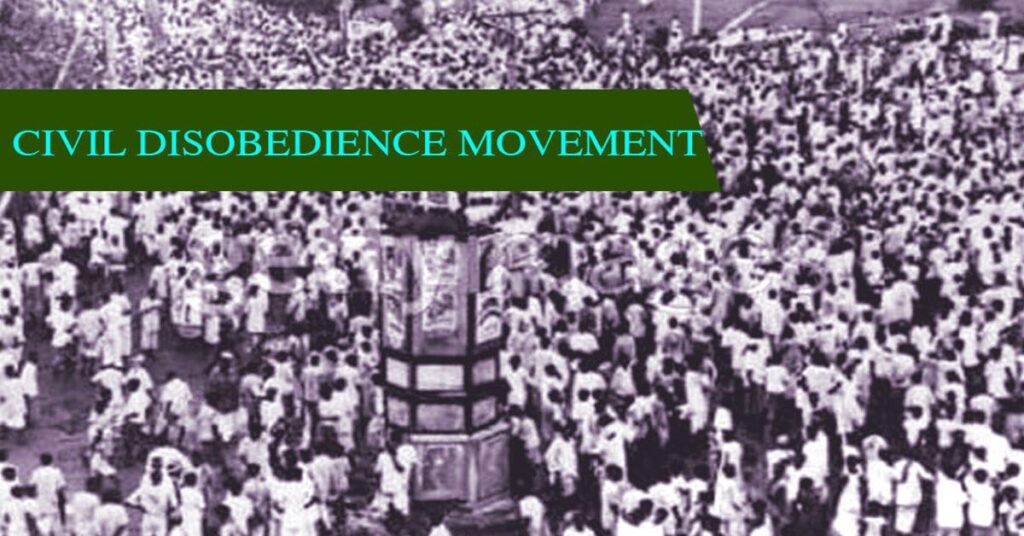Civil disobedience movement:
Civil Disobedience Movement is the refusal to submit to the requests or orders of an administration or possessing power, without falling back on brutality or dynamic proportions of resistance.
In the meantime, at the Congress meeting held in Lahore in December 1929 with Jawarharlal Nehru as the president, poorna swaraj was proclaimed as an objective. Boycotting the Round Table Conference and sending off a Civil Disobedience Movement was likewise settled.


Salt satyagraha movement:
A contract of requests was introduced to the Viceroy Lord Irwin with a final proposal to consent by 31 January 1930, They are:
- Decrease of use of armed force and common Administrations by half
- Presentation of absolute restriction
- The arrival of every single political detainee
- Decrease of land income by half
- Nullification of salt assessment
At the point when the Viceroy didn’t answer the contract of requests, Gandhi sent off the Civil Disobedience Movement. It changed into a mass development drawing all segments of the populace to the roads. The parade turned out to be increasingly large when hundreds went along with them along the walk. At 61 years old, Gandhi covered a distance of 241 miles in 24 days to arrive at Dandi at dusk on fifth April 1930.
Round table conference:
Amidst the development, the First Round Table Conference was held in London in November 1930. Ramsay Macdonald, the British Prime Minister, proposed a national government with common independence. Master Irwin held talks that brought about the Gandhi-Irwin Pact on 5 March 1931.
Congress consented to suspend the Civil Disobedience Movement and go to the meeting. Gandhi went to the Second round Table Conference which started on seventh Sep 1931. Gandhi wouldn’t acknowledge separate electorates for minorities. Subsequently, the subsequent gathering finished with practically no outcome.
Restoration of civil disobedience movement:
On getting back to India, Gandhi resuscitated the Civil Disobedience Movement. This time the public authority was ready to meet the opposition. Military regulation was upheld and Gandhi was captured on the fourth of January 1932.
Before long all the Congress chiefs were captured as well. Meanwhile, The Third Round Table Conference was held from seventeenth November to 24 December 1932. Congress didn’t partook in that frame of mind as it had resuscitated the Civil Disobedience Movement.
Common award:
On 16 August 1932, Ramsay MacDonald reported the Communal Award. It gave separate electorates to the minorities like Muslims, Sikhs, Indian Christian, Anglo-Indians, ladies, and the discouraged classes.
On the 15th of September 1932, Gandhi went on a quick demise against the different electorates for the discouraged classes. Madan Mohan Malaviya, Rajendra Prasad, and others held chats with Ambedkar and M.C. Rajah the heads of the discouraged classes.
The crusade against untouchability:
Gandhi gave not many years towards the annulment of distance. His sidekick with Dr. B.R. Ambedkar had a major effect on his thoughts regarding the rank framework. He moved his base to Sathyagraha Ashram at Wardha.
He attempted an all-India visit called the Harijan Tour. He began the Harijan Sevak Sangh to work for the expulsion of separation. Gandhi attempted to advance schooling, tidiness, and hygiene and surrender alcohol to the discouraged class. The work among the discouraged classes and the tribals took the message of patriotism to the grassroots.
Conclusion:
The Gandhi-Irwin arrangement emotionally finished the common noncompliance development. It was endorsed on March 5, 1931, by Mahatma Gandhi and Lord Irwin, then the Viceroy of India.
